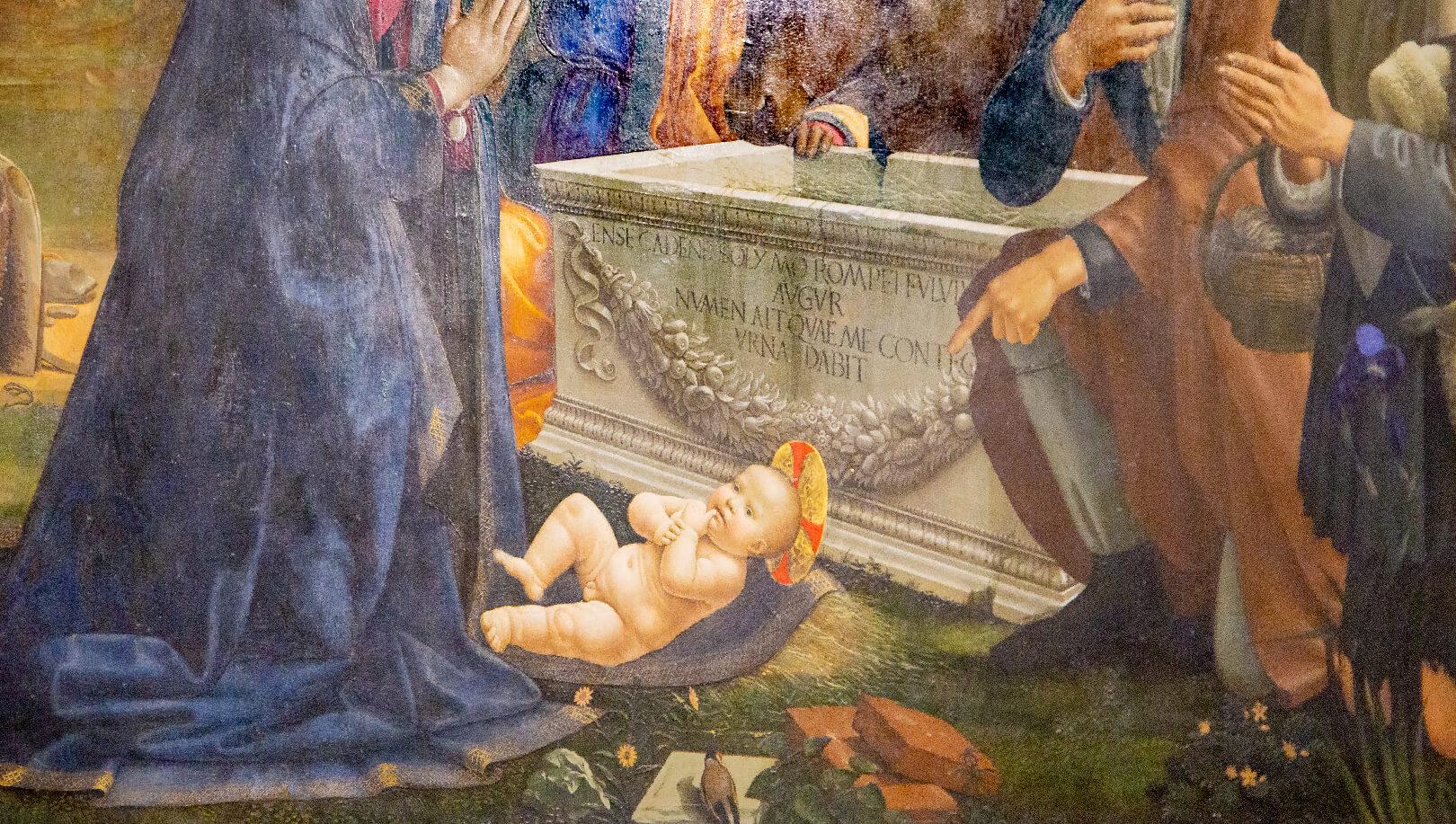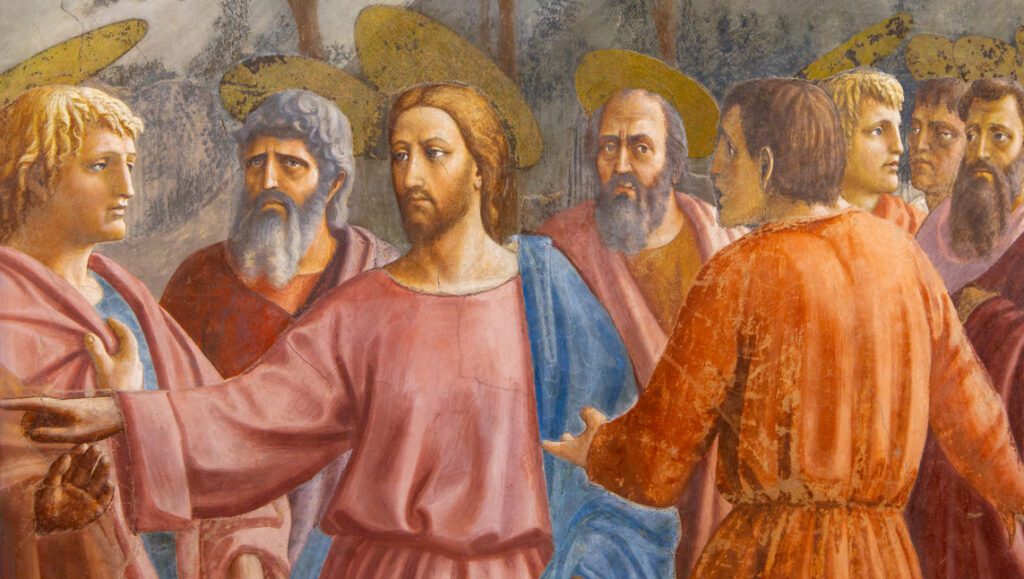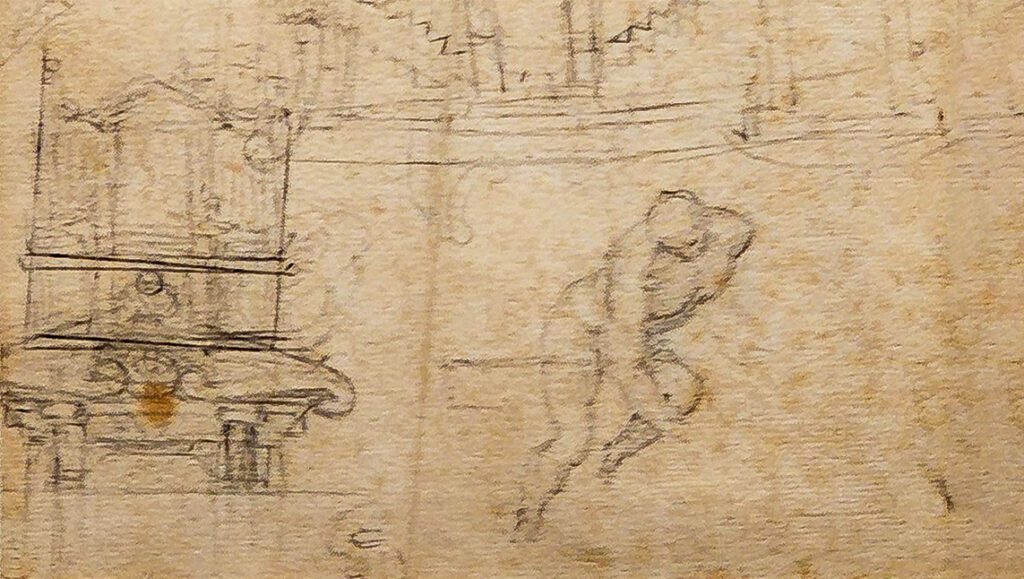
A Renaissance painting in an ancient church in the heart of Florence
It seems rather unlikely that in the core of Florence, in a street frequented mainly by tourists attracted by the great fashion brandstores of , there is a large Renaissance painting. This is what happens in Via Tornabuoni where, at the end of the road, almost near the bridge that allows crossing the Arno river, there is the Santa Trinita Church. In this day the building has a Baroque façade that hides the antiquity of the church. It is only by entering the interior that, walking through the naves, it gets to perceive the history and richness of this place which is one of the most important in Florence. On the side of the right transept is where the Sassetti Chapel is located. The decoration of this chapel was commissioned by the wealthy merchant and commercial agent on the Medici family’s behalf, Francesco Sassetti. The walls of the chapel are divided into three registers in which Domenico del Ghirlandaio — a painter who had already achieved particular fame thanks to important commissions — created scenes from Saint Francis of Assisi’s life, the name-day saint of the client who, together with his wife, he is portrayed in the back wall of the chapel in a prayerful attitude. The two kneeling figures converge towards the center, where the altarpiece which is always by Ghirlandaio and which depicts the Adoration of the Shepherds. This tempera on panel, which comes in the square format commonly called ancient, is one of the most significant works of the Florentine Renaissance. In addition to this, one of the reasons to admire this very elegant altarpiece is to snatch the secrets of a Renaissance painting that is located in the heart of Florence, nearby a street where mostly superficial tourists pass.
In this work it is where Ghirlandaio comes to condense symbolic references of great strength. At the center of the composition is where we see the child Jesus – lying on the ground – worshipped by his mother, Joseph and a group of shepherds. The series of these characters on the foreground possess an emotional charge and a monumentality of great impact that in itself would be enough material for this painting. But Ghirlandaio wants to give us the whole Gospel context; here he is, therefore in the background it’s possible to see represented on the left by the Magi’s procession coming from afar and crossing a Roman triumphal arch as it approaches the Nativity’s hut.

Adoration of the shepherds, Domenico Ghirlandaio, 1485, Santa Trinita Church
The painting and its series of symbolic references
This constitutes one of the first symbolic references that the artist endows with in the work; the custom in Christian iconography to represent classical architecture quoting as a reference to pagan antiquity’s end. A new era has begun: that of salvation, symbolised by Christ’s coming. What instead is represented by Ghirlandaio on the background right side is a layout similar to what was made by Ghirlandaio himself with the St. Peter and Andrew’s Vocation in the Sistine Chapel, namely, the inserts of the cities of Jerusalem and Rome, conceived with great imagination by the painter— as can be seen by the free quoting of ancient monuments such as Hadrian’s Mausoleum.
Ghirlandaio already reworked this theme in the early seventies of the fifteenth century when, at the beginning of his career, the painter was influenced by the style of Verrocchio of whom he frequented the flourishing master’s workshop: an excellent example is the Ruskin Madonna, a beautiful painting on wood preserved at National Galleries of Edinburgh, a very refined work that it had been the opportunity to see again in Florence in the monographic exhibition dedicated to Verrocchio at Palazzo Strozzi a few months ago.

Sassetti Chapel, D.Ghirlandaio, 1485, Santa Trinita Church
Lippi’s model reworked by Ghirlandaio
By the Ruskin Madonna had been reworking an original model of the worshipping Virgin formerly elaborated by Filippo Lippi, as it can be seen in some Lippi’s works of the Uffizi Gallery. By the Edinburgh Madonna, the composition of Ghirlandaio was enriched by a monumental architectural background consisting of a classic ruined building — a topos, as has been said, alluding to the end of the ancient world. An important datum of the Verrocchio’s influence is given here by Ghirlandaio’s attention paid to the atmospheric light’seffects which can be directly compared to the praying Madonna that Verrocchio painted — now kept at the National Gallery of London.
In the Santa Trinita altarpiece, Domenico has come to refine his style: here he has become a mature artist who has assimilated and made his various stylistic influences.
Even by comparing the same Ruskin Madonna with the Virgin of the Sassetti’s painting is possible to see how Ghirlandaio has become more confident in the rendering some details — above all the Virgin’s hands positioning that is carried out with more confidence.
Flemish painting influences
One of the most significant artistic experiences of Ghirlandaio’s training was that of Flemish painting: it’s possible to see how, compared to the diaphanous light of theRuskin Madonna, in the Sassetti altarpiece the chromatic modulation is more calibrated and denser at the same time, and that was thanks to the important influence exercised on him by the presence of Flemish artists in Florence— such as Memling and Van Eyck for example — but above all for the view of “foreign” works that were permanently destined to the Florentine churches. An emblematic case was, for example, the arrival in Florence — after a trip that can be said to be daring – of the Portinari Triptych, a masterpiece by Hugo Van Der Goes.
One of the secrets of this Renaissance painting in the core of Florence is revealed just through a comparison between the Sassetti altarpiece and the Portinari Triptych that is certainly feasible in some details, such as the position of the praying Virgin or, even more, in the hair and in the similar attitudes of the shepherds on the right side of the table.
Hovewer, the Flanders manner is mitigated by Ghirlandaio through the classical tradition that was typical of the Florentine painting of those decades, a painting that sometimes caracterised from an archaeological taste to which the Verrocchio’s workshop had contributed in a non-secondary way. In this regard it should be opportunely remembered that the great Leonardo Da Vinci had his training in the Verrocchio’s workshop. This fact is as interesting as evident is the fact that Leonardo himself followed this taste for the ancient, as it can be seen in the Annunciation of the Uffizi Gallery. In this refined painting, Leonardo places an “old-fashioned” sarcophagus under the lectern where the Virgin is intent on reading.
It is well known to scholars that that sarcophagus painted by Leonardo is a free tribute to his master who had made a similar sarcophagus in the San Lorenzo church for the burials of Piero and Giovanni de Medici, the Cosimo the elder’s sons. The mediation of antiquing taste is also what can be found in the Sassetti altarpiece where, in an almost arcadian-style quote, Ghirlandaio places an ancient sarcophagus behind the figure of the Virgin.
The insertion of a sarcophagus — an object that immediately refers to the concept of death — in a context like this in which what is celebrated is the exact opposite of death, that is, a new birth, seems somewhat strange in this context.

Detail of the Adoration of the Shepherds, D.Ghirlandaio, 1485, Chiesa Santa Trinita, Firenze
Although apparently in contradiction, the presence of the sarcophagus in this nativity takes on a Christian symbolism of great importance. Another element of particular interest is given by the altarpiece’s subject, in which we strangely wanted to give greater emphasis to the Adoration of the Shepherds in place of the Adoration of the Magi — arranged in the background — a subject which the latter above all in Florence it had great popularity with merchants who commissioned works of art in churches.
The secrets of a painting in the core of Florence
The fact of opting for an Adoration of the Shepherds instead of an Adoration of the Magi arouses particular curiosity when it is learned that the choice is linked both to the name of the client — Francesco — whose name is celebrated here on the walls of the chapel by the St Francis’ stories, and for the proximity of this chapel to that of another important Florentine family — that of Strozzi. In the latter chapel is where there were once two extraordinary altarpieces, made by Beato Angelico and Gentile da Fabriano. These two amazing paintings are still preserved in Florence: one in the San Marco Museum and the other in the Uffizi.
The long series of symbolic references and secrets still to be revealed of this Renaissance painting in the core of Florence can be discovered with a guided tour of the Church of Santa Trinita. The visit to the church can be included in an itinerary of the historic centre of the town which can become an alternative way to discover the cradle of Renaissance ⟣



